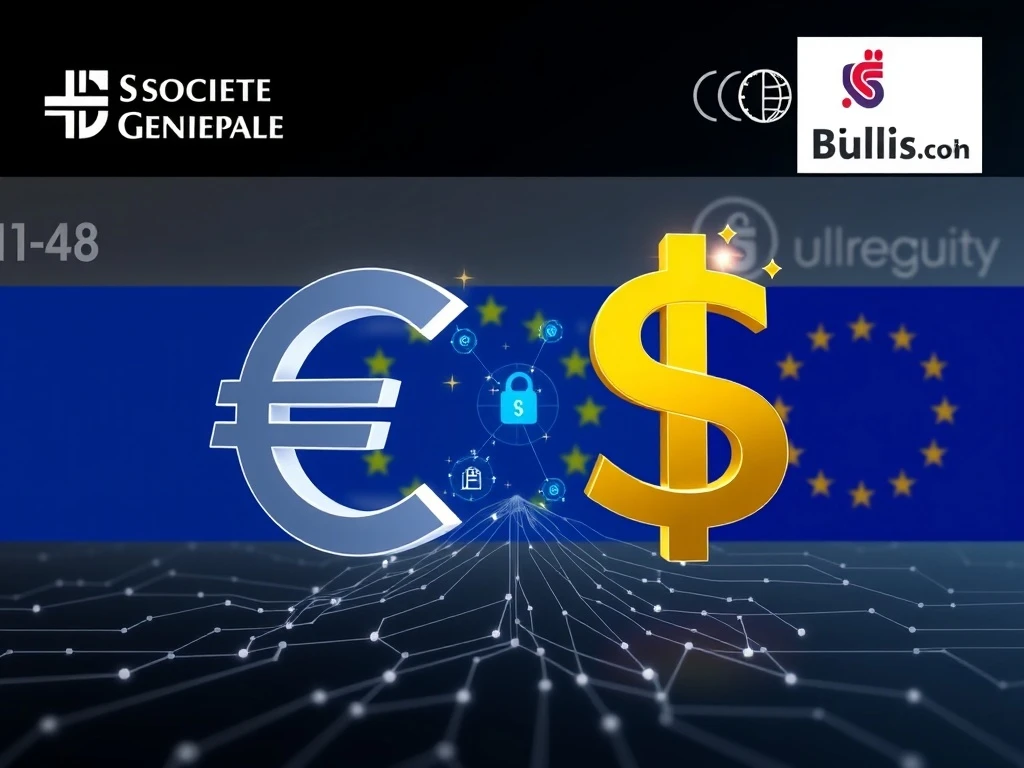MiCA Stablecoin Takes Center Stage: Société Générale’s USDCV Achieves Crucial Debut on Bullish

The European crypto market witnesses a significant milestone. Société Générale-Forge recently launched its MiCA stablecoin, USDCV. This debut happened on the Bullish exchange, marking a new era for regulated digital assets. This event underscores Europe’s growing commitment to a compliant digital finance ecosystem.
Société Générale Pioneers USDCV Launch on Bullish
Société Générale-Forge has officially introduced its USD CoinVertible (USDCV). Bullish Europe, notably, became the first platform to list this innovative stablecoin. Consequently, regulated digital assets are now more accessible across the European Union. Bullish’s German Federal Financial Supervisory Authority (BaFin) and Markets in Crypto-Assets Regulation (MiCA) regulated trading platform supports this offering. This strategic move follows a June announcement. Société Générale-Forge revealed its intention to launch the stablecoin. US-based financial services firm Bank of New York Mellon acts as the custodian. This debut also builds upon the company’s 2023 launch of its euro-pegged stablecoin, EUR CoinVertible (EURCV). That stablecoin primarily served institutional customers. However, USDCV aims to serve both retail and institutional markets. Its intended uses span remittances, foreign exchange, payments, and as a reliable store of value. Both USDCV and EURCV qualify as e-money tokens within the EU. They are freely transferable under the bloc’s MiCA rules. Furthermore, Société Générale-Forge has secured an electronic money institution license. The Autorité de Contrôle Prudentiel et de Résolution, the French regulator, issued this license. This ensures full regulatory compliance for their stablecoin operations.
Expanding the Reach of MiCA Stablecoin Adoption in Europe
The listing on Bullish exchange represents a crucial step forward. It validates the MiCA framework for stablecoins. Europe, in fact, actively develops its stablecoin ecosystem. This contrasts sharply with past dominance by United States-based initiatives. Several new ventures have emerged recently. For instance, EURAU, a new euro stablecoin, debuted on the Ethereum blockchain at the end of July. Deutsche Bank’s DWS, Flow Traders, and Mike Novogratz’s Galaxy back EURAU. BaFin also approved this stablecoin in early July. In the same month, stablecoin issuer Paxos launched the Global Dollar (USDG) stablecoin in the EU. Paxos complies fully with MiCA. It also benefits from oversight by regulators in Finland and Singapore. Earlier this year, ten stablecoin issuers received approval under MiCA. Notably, market leader Tether’s USDt (USDT) was not among them. This highlights a clear regulatory preference within the European market. Such developments showcase Europe’s proactive approach to digital asset innovation.
Navigating European Crypto Regulation and Emerging Risks
Despite significant regulatory progress, European crypto regulation faces warnings. EU officials continue to highlight risks tied to stablecoins. These concerns are particularly strong for those issued outside the bloc. Last week, a senior Bank of Italy official issued a stark warning. Stablecoins issued by multiple entities across different countries pose significant risks. These risks threaten the European Union’s financial system unless strictly limited. Christine Lagarde, President of the European Central Bank (ECB), also called for policymakers to address gaps in stablecoin regulation earlier this month. Lagarde pointed specifically to stablecoins issued beyond the “robust” MiCA framework. Her remarks follow late July warnings by ECB adviser Jürgen Schaaf. He argued that US stablecoins pose a danger to the euro. Schaaf stated, “If we forgo a common approach, we risk fuelling instability, regulatory arbitrage and global US dollar dominance.” In mid-April, Italy’s Minister of Economy and Finance warned about US stablecoin policies. He viewed them as a bigger threat to the local economy than US tariffs. Like Schaaf, he emphasized that the growing appeal of US stablecoins to Europeans should not be underestimated. This demonstrates a cautious yet forward-looking regulatory environment.
The Future Trajectory of Société Générale and Regulated Digital Assets
Société Générale continues to lead institutional crypto adoption. Their USDCV launch further reinforces this position. The move by Bullish exchange provides a regulated gateway. This allows broader access to compliant digital assets. The MiCA framework establishes clear guidelines for stablecoins. It aims to foster innovation while simultaneously mitigating risks. This structured approach could indeed define Europe’s digital finance future. The market now awaits further developments. More traditional financial institutions may follow this regulated path. Consequently, this could significantly strengthen the EU’s financial system. The ongoing dialogue between innovators and regulators will shape the next phase of this evolution. Europe is actively building a framework for digital assets that balances growth with stability. This commitment positions the region as a leader in regulated crypto innovation.







